Torticollis meaning. Torticollis: Understanding Causes, Symptoms, and Treatment Options for Wryneck
What is torticollis and how does it affect neck movement. What are the main causes of congenital and acquired torticollis. How is torticollis diagnosed and what treatment options are available. Can torticollis be prevented or managed effectively.
What is Torticollis? Defining the Twisted Neck Condition
Torticollis, also known as wryneck, is a condition characterized by an abnormal twisting of the neck that causes the head to rotate and tilt at an unusual angle. The term “torticollis” originates from Latin, with “tortus” meaning twisted and “collum” meaning neck. This condition can significantly impact a person’s ability to move their head and neck normally.
Torticollis can be classified into two main types:
- Congenital torticollis: Present at birth or noticed within the first few weeks of life
- Acquired torticollis: Develops later in infancy, childhood, or adulthood
Understanding the nature of torticollis is crucial for proper diagnosis and treatment. How does torticollis affect daily life? The persistent head tilt and limited neck movement can interfere with various activities, including eating, sleeping, and social interactions. In infants, it may also impact their developmental milestones and lead to other conditions like plagiocephaly (asymmetrical head shape).
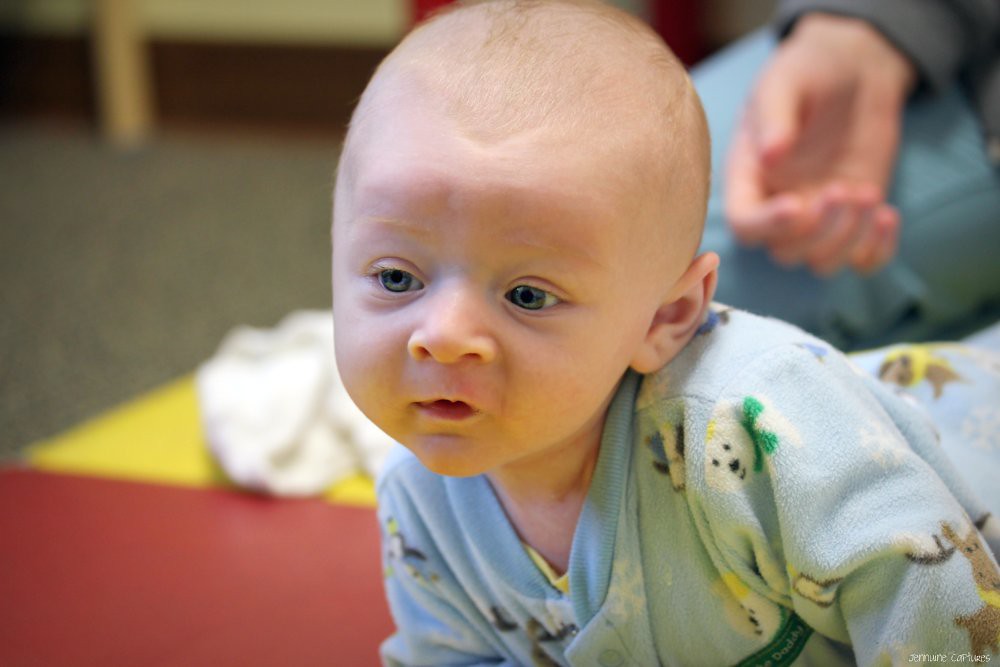
Unraveling the Causes of Torticollis: From Birth to Adulthood
The exact cause of torticollis can vary depending on whether it’s congenital or acquired. For congenital muscular torticollis, the most common form, several factors may contribute to its development:
- Intrauterine positioning: The fetus’s position in the uterus may lead to injury or shortening of the neck muscles
- Birth trauma: Difficult deliveries or use of assistive devices may cause neck muscle injury
- Genetic factors: Some cases may have a hereditary component
Acquired torticollis can result from various causes, including:
- Neck muscle spasms or injuries
- Cervical spine abnormalities (e.g., herniated discs, slipped facets)
- Infections affecting the neck region
- Neurological conditions
- Certain medications or toxins
Is torticollis more common in certain populations? Studies suggest that congenital muscular torticollis is more prevalent in firstborn children and may be associated with other congenital conditions like hip dysplasia. However, acquired torticollis can affect individuals of any age.
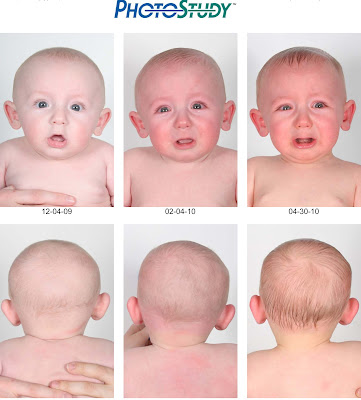
Recognizing the Signs: Key Symptoms of Torticollis
Identifying torticollis early is crucial for effective treatment. The primary symptoms of torticollis include:
- Persistent head tilt to one side
- Chin rotation toward the opposite shoulder
- Limited range of motion in the neck
- Neck muscle pain or stiffness
- Uneven shoulder heights
- Difficulty turning the head
In infants with congenital torticollis, additional signs may include:
- Preference for turning the head to one side while sleeping
- Difficulty breastfeeding on one side
- Development of a flat spot on one side of the head (plagiocephaly)
Can torticollis symptoms vary in severity? Yes, the degree of head tilt and neck stiffness can range from mild to severe. Some individuals may experience intermittent symptoms, while others have persistent discomfort and limited mobility.
Diagnosing Torticollis: From Physical Examination to Imaging Studies
Accurate diagnosis of torticollis typically involves a comprehensive approach:
- Medical history: The healthcare provider will inquire about the onset of symptoms, any related injuries or conditions, and family history.
- Physical examination: This includes assessing neck range of motion, muscle strength, and head position.
- Imaging studies: X-rays, CT scans, or MRI may be ordered to rule out underlying structural abnormalities or tumors.
- Neurological evaluation: This may be necessary to check for any nerve-related issues contributing to the condition.
How do doctors differentiate between different types of torticollis? The diagnosis process helps distinguish between muscular torticollis and other forms caused by neurological or skeletal issues. This differentiation is crucial for determining the most appropriate treatment plan.
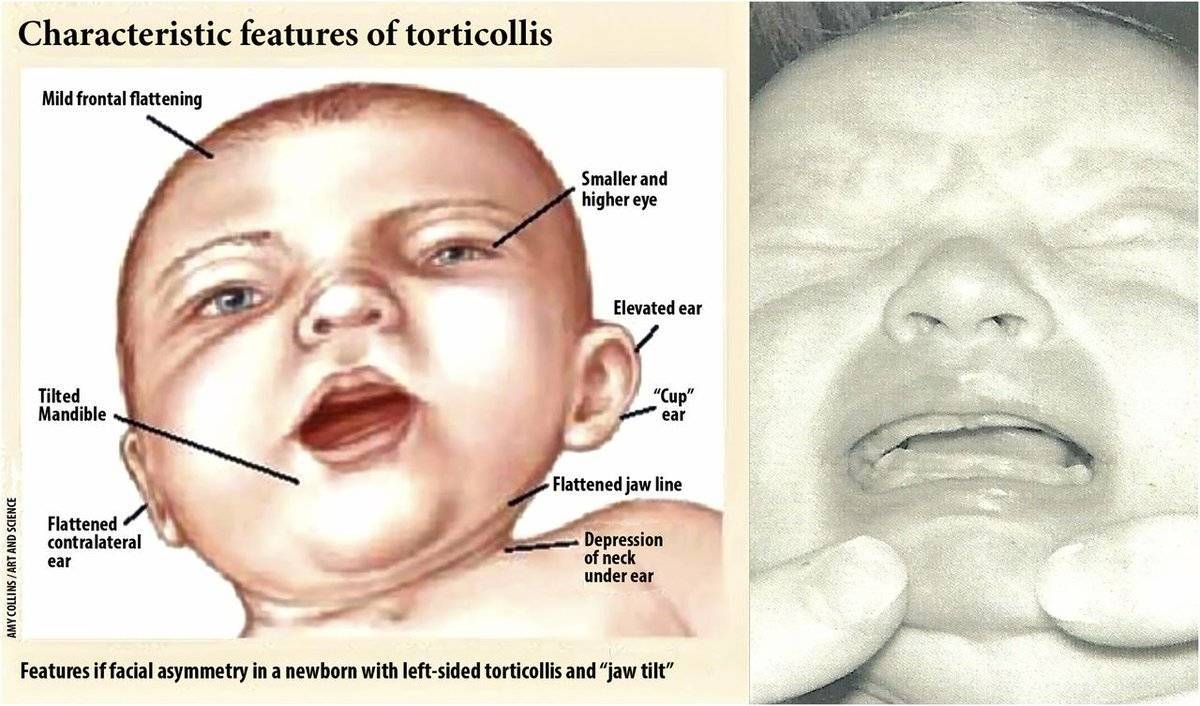
Specialized Tests for Complex Cases
In some instances, additional tests may be required:
- Electromyography (EMG) to assess muscle function
- Blood tests to check for infections or inflammatory conditions
- Genetic testing if a hereditary component is suspected
Treatment Approaches: From Conservative Methods to Surgical Interventions
The treatment of torticollis depends on its underlying cause, severity, and duration. Common treatment options include:
- Physical therapy: Stretching and strengthening exercises to improve neck mobility and posture
- Massage and manual therapy: To relax tight muscles and reduce pain
- Botulinum toxin injections: For cases involving muscle spasms or dystonia
- Medications: Anti-inflammatory drugs or muscle relaxants to alleviate pain and stiffness
- Orthotic devices: Neck braces or collars to support proper head positioning
- Surgery: In severe or persistent cases, especially those involving structural abnormalities
What is the success rate of torticollis treatment? With early intervention and appropriate treatment, many cases of torticollis, especially in infants, can be successfully managed. For congenital muscular torticollis, studies show that over 90% of cases respond well to conservative treatments like physical therapy when started within the first year of life.
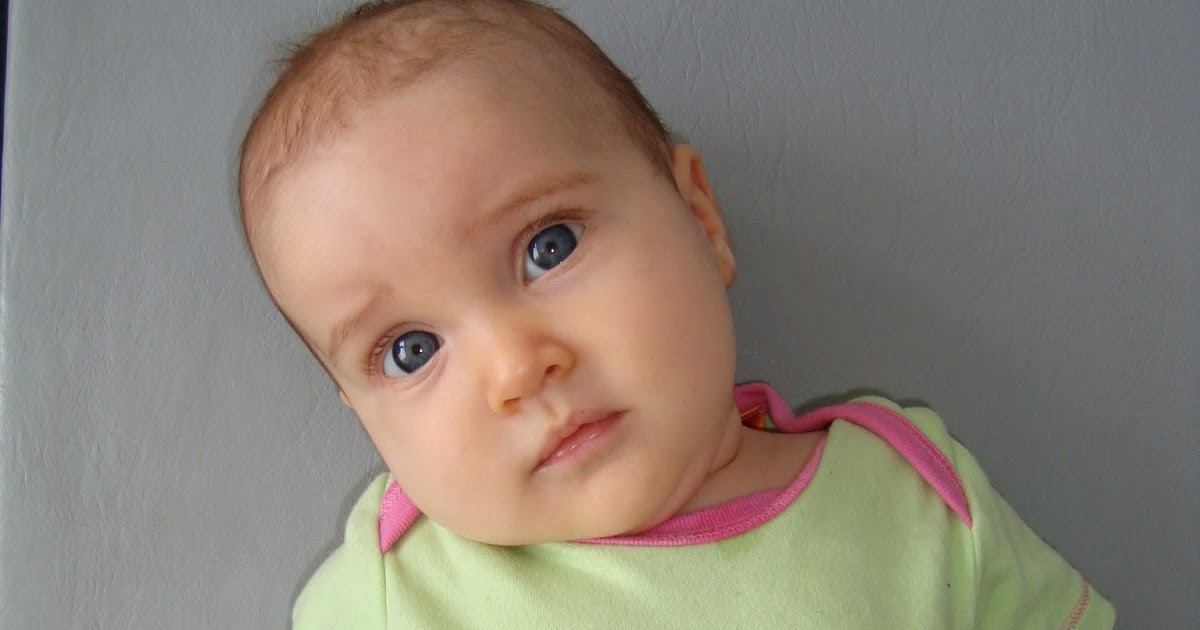
Innovative Treatment Approaches
Emerging treatments for torticollis include:
- Biofeedback therapy to improve muscle control
- Acupuncture for pain management and muscle relaxation
- Virtual reality-based rehabilitation exercises
Living with Torticollis: Coping Strategies and Lifestyle Adjustments
Managing torticollis often requires ongoing efforts and lifestyle modifications:
- Regular exercise and stretching routines
- Proper ergonomics at work and home
- Use of supportive pillows and positioning aids
- Stress management techniques to reduce muscle tension
- Adaptation of daily activities to accommodate limited neck mobility
How can family members support individuals with torticollis? Family support is crucial in managing torticollis, especially for children. This may involve assisting with exercises, providing emotional support, and helping to create a comfortable home environment that accommodates the condition.
Emotional and Psychological Aspects
Living with torticollis can have psychological impacts, including:
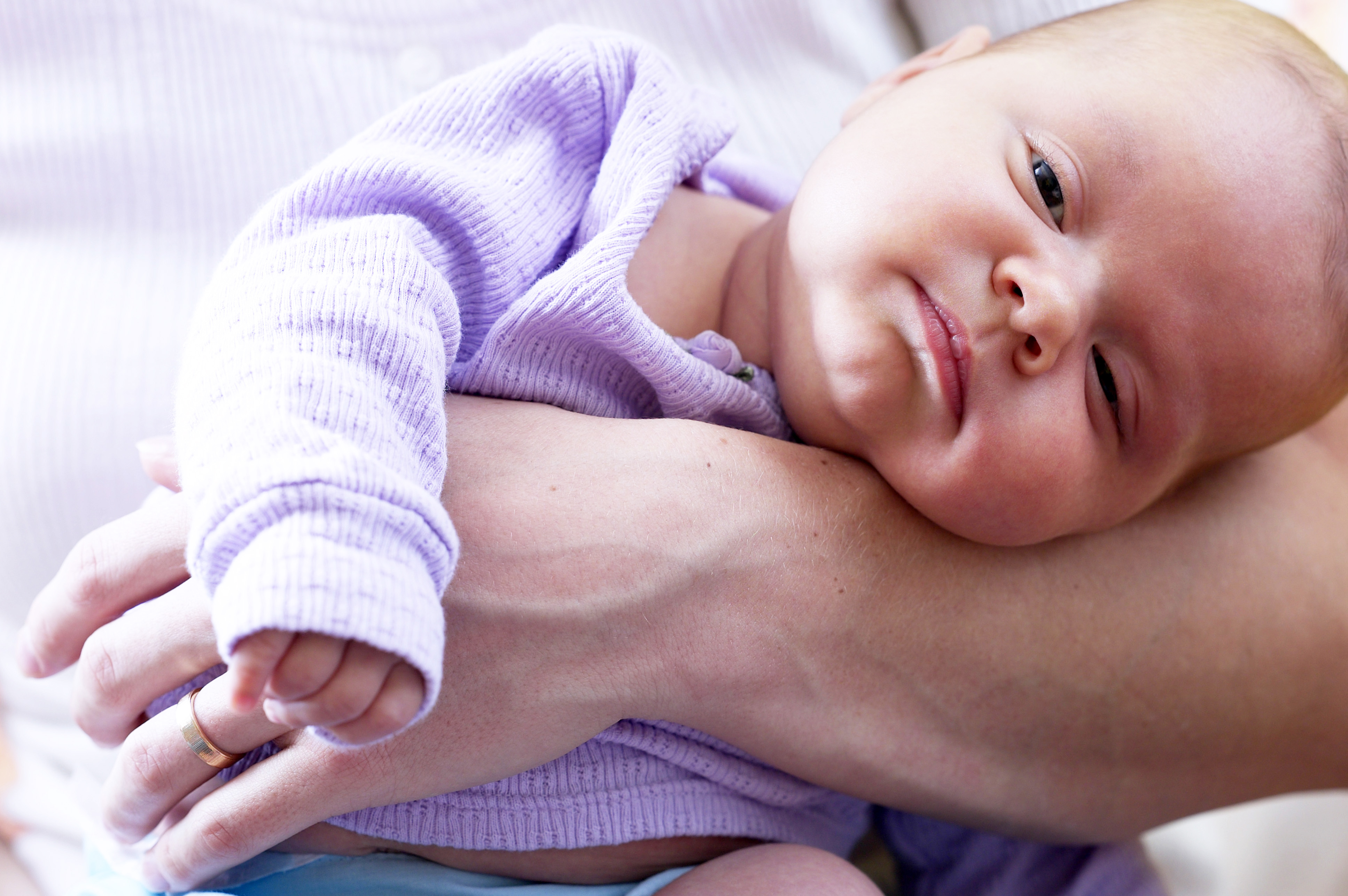
- Self-esteem issues due to visible head tilt
- Anxiety about social interactions
- Frustration with physical limitations
Seeking counseling or joining support groups can be beneficial in addressing these emotional challenges.
Preventing Torticollis: Proactive Measures for Better Neck Health
While not all cases of torticollis can be prevented, certain measures may reduce the risk or severity:
- Proper positioning of infants during sleep and playtime
- Regular “tummy time” for babies to strengthen neck muscles
- Maintaining good posture and ergonomics throughout life
- Avoiding prolonged static positions, especially when using electronic devices
- Regular neck exercises and stretches
- Prompt treatment of neck injuries or infections
Can adult-onset torticollis be prevented? While some cases are unavoidable, maintaining good neck health through regular exercise, proper posture, and avoiding excessive strain can help reduce the risk of developing acquired torticollis in adulthood.
Risk Factors to Be Aware Of
Certain factors may increase the likelihood of developing torticollis:
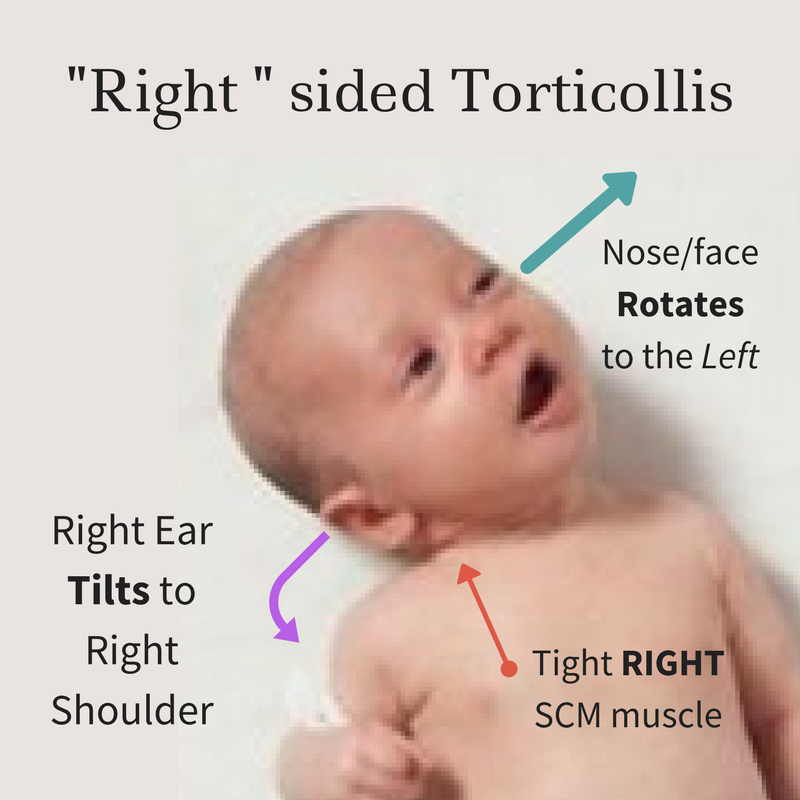
- Family history of muscular or skeletal disorders
- Occupations involving repetitive neck movements or prolonged static postures
- History of neck injuries or trauma
- Certain neurological conditions
Torticollis Research: Current Studies and Future Directions
Ongoing research in torticollis aims to improve understanding, diagnosis, and treatment of the condition:
- Genetic studies to identify potential hereditary factors
- Advanced imaging techniques for earlier and more accurate diagnosis
- Development of targeted therapies for specific types of torticollis
- Investigation of long-term outcomes and quality of life in individuals with torticollis
What breakthroughs can we expect in torticollis treatment? Emerging research areas include stem cell therapy for muscle regeneration, advanced robotics for rehabilitation, and personalized treatment protocols based on genetic and biomechanical factors.
Collaborative Research Initiatives
International collaborations are driving progress in torticollis research:
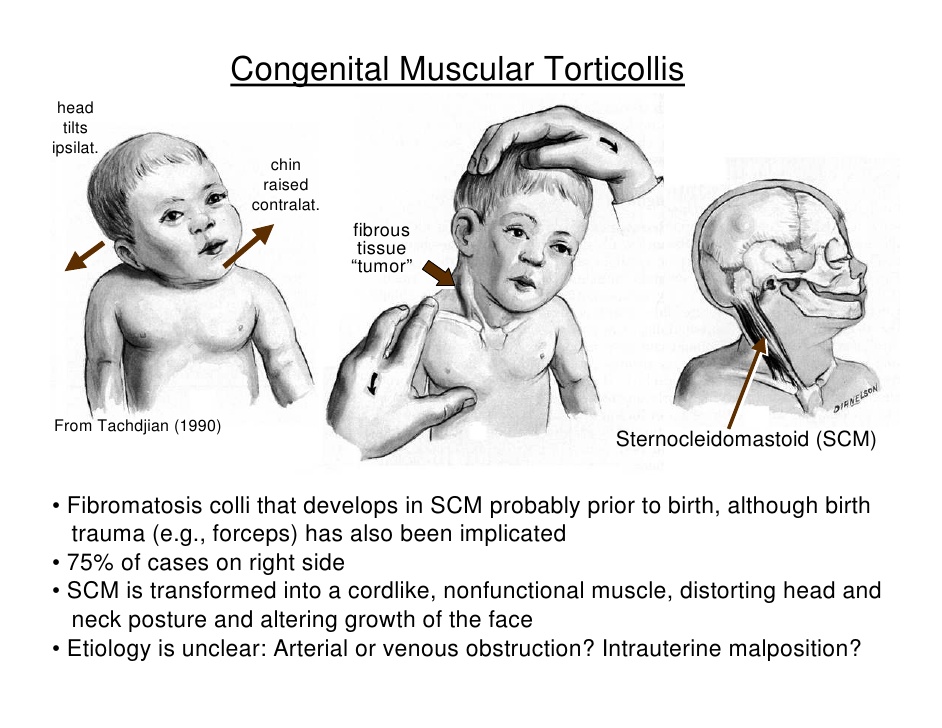
- Multi-center clinical trials for new treatment modalities
- Establishment of global registries to track long-term outcomes
- Interdisciplinary studies combining expertise from neurology, orthopedics, and rehabilitation medicine
The field of torticollis research is dynamic, with new insights continually emerging to enhance our understanding and management of this complex condition.
Torticollis (Wryneck) | Johns Hopkins Medicine
What is torticollis?
Torticollis, also known as wryneck, is a twisting of the neck that causes the head to rotate and tilt at an odd angle.
What causes torticollis?
The exact cause of torticollis is unknown.
Congenital muscular torticollis is more likely to happen in firstborn children. This may also be accompanied by a congenital hip dislocation. The cause is likely from the fetus’s position in the uterus resulting in injury to the neck muscles.
Acquired torticollis may be caused by irritation to the cervical ligaments from a viral infection, injury, or vigorous movement. Additional causes may include:
- Sleeping in an awkward position
- Neck muscle injury at birth
- Burn injury
- Any injury that causes heavy scarring and skin or muscle shrinkage
- Neck muscle spasm
Torticollis may also be a secondary condition that results from the following:
- Slipped facets (two small joints on the side of the spine)
- Herniated disk
- Viral or bacterial infection
What are the symptoms of torticollis?
The following are the most common symptoms of torticollis. However, each person may experience symptoms differently. Symptoms may include:
However, each person may experience symptoms differently. Symptoms may include:
- Neck muscle pain or pain down the spine
- Inability to turn the head, usually holding it twisted to one side
- Spasm of the neck muscles
- Awkward position of the chin
The symptoms of torticollis may resemble other conditions and medical problems. Always consult your healthcare provider for a diagnosis.
How is torticollis diagnosed?
Diagnosis of torticollis usually is confirmed with a medical history and physical exam.
How it torticollis treated?
Specific treatment for torticollis will be determined by your healthcare provider based on:
- Your age, overall health, and medical history
- Extent of the condition
- Your tolerance for specific medicines, procedures, or therapies
- Expectations for the course of the condition
- Your opinion or preference
Treatment may include:
- Neck collar
- Heat therapy
- Ultrasound therapy
- Physical therapy
- Surgery
When should I call my healthcare provider?
If your symptoms have not improved within the time frame suggested by your healthcare provider, you should let him or her know. Also, if your symptoms get worse or you get new symptoms, you should let your provider know.
Also, if your symptoms get worse or you get new symptoms, you should let your provider know.
Key points about torticollis
- It is a twisting of the neck that causes the head to rotate and tilt at an odd angle.
- The exact cause is unknown. It can be congenital or acquired.
- Diagnosis is usually confirmed by history and physical exam.
Next steps
Tips to help you get the most from a visit to your healthcare provider:
- Know the reason for your visit and what you want to happen.
- Before your visit, write down questions you want answered.
- Bring someone with you to help you ask questions and remember what your provider tells you.
- At the visit, write down the name of a new diagnosis, and any new medicines, treatments, or tests. Also write down any new instructions your provider gives you.
- Know why a new medicine or treatment is prescribed, and how it will help you. Also know what the side effects are.

- Ask if your condition can be treated in other ways.
- Know why a test or procedure is recommended and what the results could mean.
- Know what to expect if you do not take the medicine or have the test or procedure.
- If you have a follow-up appointment, write down the date, time, and purpose for that visit.
- Know how you can contact your provider if you have questions.
Torticollis | Boston Children’s Hospital
Unlike many health conditions that develop silently inside the body, torticollis is easy to see from the outside. You can recognize it when your child’s head persistently tilts to one side.
The word “torticollis” itself comes from two Latin root words, “tortus” and “collum,” that together mean “twisted neck.” This condition, sometimes called wryneck, is relatively common in children.
In general, torticollis is classified as either congenital (present at birth) or acquired (occurring later in infancy or childhood). By far the most common type is congenital muscular torticollis. Although children have this when they are born, parents may not notice it until children are several weeks old, as they start to gain more control of their head movement.
By far the most common type is congenital muscular torticollis. Although children have this when they are born, parents may not notice it until children are several weeks old, as they start to gain more control of their head movement.
- Congenital muscular torticollis responds very well to physical therapy, especially when it’s started early. Sometimes it is associated with plagiocephaly, a common and treatable condition in which there is asymmetry in the shape of the head and face. This happens because the forces of gravity pull unevenly on a baby’s tilted head, causing a flattened appearance on one side of the skull or face.
- Acquired torticollis typically occurs in the first four to six months of childhood or later. It may come on quickly or slowly. In contrast to congenital muscular torticollis, there is usually no facial asymmetry with acquired torticollis.
- Acquired torticollis can be benign (not serious) or a sign of more serious health issues. Because the causes can be so different, it is very important to act quickly so that your child can get the proper care and treatment.

Note: Pediatric torticollis is different from another condition, called spasmodic torticollis, that affects adults.
What are the symptoms of torticollis?
Congenital muscular torticollis
- The child has a limited range of motion in the head and neck.
- The head tilts to one side while the chin tilts to the other.
- A small, pea-sized lump (or “pseudo tumor”) is sometimes found on the sternocleidomastoid (SCM) muscle.
- Asymmetries of the head and face, indicating plagiocephaly, may also be present.
- Musculoskeletal problems, such as hip dysplasia, are sometimes present.
Acquired torticollis
- There is limited range of motion in the head and neck.
- The head tilts to one side while the chin tilts to the other.
- With a condition called benign paroxysmal torticollis, there may be recurrent episodes, or “attacks,” of head tilting; often these attacks are accompanied by other symptoms, such as vomiting, irritability, and/or drowsiness.

- Additional symptoms vary according to the cause of the torticollis.
Note: Children who develop torticollis that is associated with neck pain after trauma (even minor trauma) should be evaluated right away to make sure they do not have any subluxation of the C1 or C2 vertebrae. In addition, children who develop painful torticollis at the same time as a fever that is caused by an infection in the pharynx (cavity behind the nose, mouth, and larynx) or retropharyngeal space (the area behind the pharynx) need to see a doctor immediately. If left untreated, these complications can lead to a rare disorder called Grisel’s syndrome.
What are the causes of torticollis?
Because there are different types of torticollis, it is important to know the root cause so that your child can get the proper care and treatment as quickly as possible.
Congenital muscular torticollis
For children with congenital muscular torticollis, the most common form of pediatric torticollis, the SCM muscle becomes shortened and contracted. The SCM muscle runs along each side of the neck and controls how the head moves — side to side, and up and down.
The SCM muscle runs along each side of the neck and controls how the head moves — side to side, and up and down.
There are a few common reasons why the SCM muscle may have become contracted and cause your child’s head to tilt to one side:
- the way your baby was positioned in the womb before birth
- abnormal development of the SCM muscle
- trauma or damage to the muscle during birth
In far less common cases, congenital muscular torticollis may occur as a symptom of other underlying conditions, including:
- congenital bony abnormalities of the upper cervical spine, with subluxation (abnormal rotation) of the C1 vertebrae over the C2 vertebrae in the cervical spine (the part of the spine that encompasses the neck).
- congenital bony abnormalities of the upper cervical spine, which are most often associated with other congenital skeletal anomalies
- shortened neck
- short limbs (arms and legs)
- dwarfism
- congenital webs of skin running along the side of the neck
- Klippel-Feil syndrome, a rare birth defect that causes some of the neck vertebrae to fuse together
- achondroplasia, a bone growth disorder
- multiple epiphyseal dysplasia, a disease that affects the development of bone and cartilage in the long bones of the arms and legs
- Morquio syndrome, an inherited metabolic disorder that prevents the body from breaking down sugar molecules
Acquired torticollis
For children who have acquired torticollis, the causes vary widely and range in severity from benign (not serious) to very serious. Some causes of acquired torticollis include:
Some causes of acquired torticollis include:
- a mild (usually viral) infection
- minor trauma to the head and neck
- gastroesophageal reflux (GERD)
- respiratory and soft-tissue infections of the neck
- abnormalities in the cervical spine (such as atlantoaxial subluxation)
- vision problems (called ocular torticollis)
- abnormal reaction to certain medications (called a dystonic reaction)
- spasmus nutans (a usually benign condition that causes head bobbing along with uncontrolled eye movements)
- Sandifer syndrome (a rare condition combining gastroesophageal reflux with spasms in the neck)
How we care for torticollis
At Boston Children’s Hospital, we are dedicated to acting quickly to find out the root cause of torticollis and coming up with a treatment approach that’s customized for your child. In most cases, our clinicians deal with congenital muscular torticollis. We’ve found that most children with this type of torticollis respond very well to physical therapy programs, usually within a matter of months. Our dedicated team of physical therapists will provide an exercise plan that actively involves you in your child’s care.
Our dedicated team of physical therapists will provide an exercise plan that actively involves you in your child’s care.
We’ll also provide treatment plans designed for children who do not respond to physical therapy. Our orthopedic, neurosurgical, and plastic surgery experts work closely together to develop a customized treatment approach that meets all of your child’s health needs.
Frequently asked questions
How common is congenital muscular torticollis?
It is fairly common, occurring in about 1 in 300 births.
Lately I’ve noticed that my infant daughter does not hold her head straight and allows it lean to one side. What should I do?
It is important to bring your daughter to the doctor for a physical exam.
My child has congenital muscular torticollis. What can I do help stretch the sternocleidomastoid (SCM) muscle?
Your child’s physical therapist will teach you certain exercises to do at home that will manually and passively stretch the SCM muscle. These exercises are usually very effective, especially when started as soon as possible.
These exercises are usually very effective, especially when started as soon as possible.
How long will it take before we see an improvement in our son’s congenital muscular torticollis?
In general, the majority of children with congenital muscular torticollis show improvement after a few months of physical therapy, especially when it is started early. Every child is different, so be sure to discuss any concerns you may have with your son’s doctor and physical therapist. Your son may need a referral to a specialist if he has no or limited improvement after physical therapy.
Does congenital muscular torticollis affect some infants more than others?
It may affect firstborn children and twins more often because there is a greater chance of too little space, or “crowding,” in the uterus and birth canal. This can cause damage or constriction to the SCM muscle. It may also happen after a difficult birth, especially when babies are very large or have a breech delivery.
My son has been diagnosed with benign paroxysmal torticollis. Is this the same as congenital muscular torticollis?
Is this the same as congenital muscular torticollis?
No, they are separate conditions. Be sure to talk to your son’s neurologist to discuss the differences. In general, benign paroxysmal torticollis is noted by periodic bouts, or “attacks,” of torticollis, typically lasting for hours or days. Some children who are affected by this type of torticollis go on to develop migraine headaches later in life.
Torticollis – causes, symptoms, diagnosis and treatment
What can overshadow the joy of a family that has just entered a newborn man? Only concern for his health. Examination in the first days does not reveal pathologies in the baby, but some of them may appear a little later, for example, torticollis.
What is torticollis?
Under the influence of a number of factors, the muscular and bone apparatus of the neck is deformed, after which the head turns to one side when it is tilted to the opposite shoulder. Caring relatives sometimes mistakenly assume torticollis in newborns, it’s just that the child still does not know how to turn his head and change position. You should definitely tell your doctor about your suspicions.
You should definitely tell your doctor about your suspicions.
Torticollis is perhaps the most common orthopedic problem in infants.
Osteopathy considers a defect not as a separate disease, but as a complex of disorders that is congenital or acquired during life.
By showing a child to an osteopath shortly after birth, torticollis and other failures can be established quickly and without complications, even before the defect manifests itself visually, which usually occurs at 2-3 weeks, if we are talking about torticollis inherent from birth .
The main types and causes of pathologies
Congenital torticollis is based on damage to the cervical spine or a defect in the formation of the sternocleidomastoid muscle. The muscle is a steam room, it consists of two parts, which, uniting from above, are attached to the temporal process and the occipital bone, and from below – the front part to the sternum, back to the collarbone. The muscles are responsible for turning and tilting the head back, forward, to the side, and are also involved in lifting the chest during inhalation, in the movement of the jaws, in swallowing, etc.
Unilateral atrophy with simultaneous hypertrophy of the opposite muscle generates an unnatural turn of the head to the right or left side and up. Compression and compaction of both muscles causes the head to deviate backward – this is bilateral torticollis, which is much less common. Attempts to turn the head to the correct position cause the baby to cry, indicating excruciating pain.
Congenital torticollis develops more frequently and may be due to adverse factors during pregnancy:
- Infections, intoxication, drugs taken, chronic diseases, toxicosis, oligohydramnios;
- Uncomfortable position of the fetus in the womb, squeezing of the head, its tight pressing against the uterine wall or shoulder, transverse presentation;
- Muscle shortening due to intrauterine inflammation or other ontogenesis anomalies;
- Cord entanglement;
- Fetal hypoxia, insufficient blood supply to tissues.

It is not uncommon for torticollis to occur during childbirth or caesarean section when the baby’s head is pulled, including using forceps or a vacuum.
Acquired torticollis develops mainly before the age of one, but it is not excluded in adults.
Causes of secondary deformity in babies include
- Non-compliance with the rules for caring for an infant: laying on one side – in a crib, while wearing and feeding;
- Location of light, sound, toys on one side of the baby;
- Injury to the neck, including thermal, inflammation of the lymph node;
- Strabismus, hearing loss.
Acquired torticollis is easier to prevent or, if treated at the initial symptoms, easier to get rid of.
The occurrence of congenital torticollis is difficult to control and prevent, except for health care and careful preparation for childbirth. Being only a symptom, torticollis in newborns indicates a general imbalance.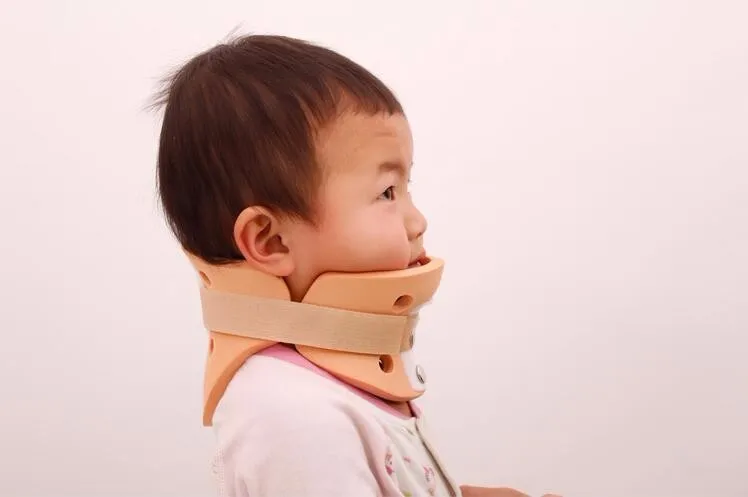 In some cases, it is supplemented by hip dysplasia and clubfoot due to skeletal deformity.
In some cases, it is supplemented by hip dysplasia and clubfoot due to skeletal deformity.
Concomitant diseases
Timely diagnosed torticollis with a correctly established form is more successfully treated. Distinguished:
- Myogenic torticollis, the most common, which is created by shortening and compression of the sternocleidomastoid muscle, subsequently leads to spinal curvature and facial asymmetry.
- Idiopathic form. Often of unknown origin, found after a difficult delivery, manifested by uneven tension of muscle tissues. High risk of CNS disorders.
- Osteogenic type. This is an anomaly in the development of the cervical vertebrae, in which they are shortened and often combined into one. The neck is practically not visible, the rotation is limited, then cervical radiculitis (inflammation of nerve fibers) is likely.
- Neurogenic. Torticollis of this type is observed with spasmodic muscle contractions not only of the neck, but of the entire torso, arms and legs on one side.
 As a result, the body is strongly curved.
As a result, the body is strongly curved.
In addition to directly related pathologies and direct consequences of torticollis, there is a high risk of destruction in various body systems:
- Children are developmentally retarded, motor and speech skills are difficult for them;
- There is a poor appetite, sleep disturbances, tearfulness;
- Hearing and vision impairment, often unilateral;
- Head deformity.
Long-term complications are possible years later.
These are painful changes in various parts of the spinal column, distortion of the lungs and deformation of the trachea, asymmetry of the face and skull, malocclusion, clamping of the carotid artery and, as a result, headaches, dizziness, brain dysfunction, excessive fatigue. In addition, the inner ear may suffer, there is an imbalance, the skeleton is skewed to the side.
If the cause is acquired manifestations of torticollis, it is necessary to determine the cause and eliminate it, thereby relieving the baby of adverse factors and improving the quality of life in general.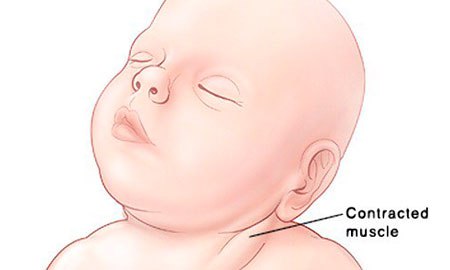
There is a risk that, together with torticollis, these circumstances create other abnormalities in a healthy infant.
Diagnosis and treatment of torticollis.
Pathology is noted by a doctor during examination, on the basis of which one or more diagnostic methods are prescribed:
- assessment of the general condition of the musculoskeletal system;
- X-ray of cervical vertebrae;
- Ultrasound of muscles and blood vessels;
- blood flow dopplerography;
- consultations of other specialists: neurologist, traumatologist.
Additional examinations may be required: MRI, CT, electroneurography (determination of the speed of nerve impulses).
In order for the treatment to be beneficial and not harmful, it is necessary to establish the complete clinical picture of torticollis, to reveal the true origin.
Depending on this, rehabilitation measures are prescribed: exercise therapy, massage, electrophoresis, recreational swimming, warming up, stretching the neck muscles. A corset, a collar-tire, a head holder are selected individually, in which the baby will spend up to several months.
A corset, a collar-tire, a head holder are selected individually, in which the baby will spend up to several months.
All this, taking into account healthy living conditions, leads to the external elimination of torticollis, the muscle reaches the required size. In severe cases, muscle excision is performed.
Torticollis also occurs in adults. Often, residual effects from infancy make themselves felt.
Or, in adulthood, the condition can be caused by the following underlying causes:
- skin damage in the cervical region by burns, postoperative or post-traumatic scars;
- destructive processes in the vertebrae of the neck, their subluxation and other abnormalities;
- infectious, toxic effects;
- a disorder in the transmission of nerve signals from the brain to the corresponding muscles, paralysis or spasticity.
The patient will be able to feel the lump in the sternocleidomastoid muscle by himself, trying to return the neck to its natural position. From such attempts, a palpable soreness arises, radiating to other parts of the body and head.
From such attempts, a palpable soreness arises, radiating to other parts of the body and head.
Deviations in the functioning of various systems and organs can also lead to torticollis, for example, endocrine, when metabolic processes in muscle tissues are disturbed.
In addition to special exercises and procedures, it is customary for adults to prescribe medications and injections to relieve muscle tension.
Torticollis through the eyes of an osteopath
Osteopathic treatment is most effective in the early stages of the disease or, in cases with congenital pathologies, in early infancy, when the body has not yet begun to adapt to disorders, creating more and more dysfunctions. Vice cannot exist in isolation.
Removing the symptoms of torticollis, the osteopath evaluates all structures in parallel.
Immediately after birth, when there is no diagnosis yet, the osteologist is able to determine the uneven development of the muscles or the displacement of the cervical vertebrae.
The doctor collects an anamnesis, asking about the course of pregnancy and childbirth, taking into account the factor of heredity.
Diagnosis in osteopathy is carried out by palpation and examination.
The size and shape of the head, the density and tension of muscle tissue, and the symmetry of the body are studied.
The osteopath uses all the available results of examinations, and if they have not been carried out, he can send them to clarify the type of disease.
At the first session, his task is to remove the increased tone, relieve pain, in order to deal with the elimination of the cause in the future.
Torticollis does not occur on its own. A newborn could experience oxygen starvation before or during childbirth, and this is fraught with multiple problems in the future, including after growing up. Deformation of the bones or muscles of the neck is an indispensable displacement of the plates of the skull, clamping of the arteries, and a violation of the venous outflow.
Interestingly, an osteopath can tell about the details of a birth based on symptoms, because a child receives certain injuries during childbirth.
Unfortunately, standard orthopedic treatments often make the situation worse by removing a visible defect. How is this possible? After all, the muscles of the neck come back to normal.
The fact is that in case of birth injuries or incorrect position of the fetus, compensatory mechanisms are triggered. The body learns to function in the prevailing conditions, rebuilding the functionality of systems to preserve life. And forced stretching of the muscle can lead to undesirable results, the connection of which with corrective techniques is difficult to establish.
An osteopathic session for the little ones lasts an average of 20 minutes. Manipulations are absolutely painless, sometimes children fall asleep under the gentle movements of the doctor’s hands.
Crying, as a rule, indicates the presence of strong clamps and blocks, and the osteopath works with them as carefully as possible. If the patient becomes excessively anxious, the session is suspended.
If the patient becomes excessively anxious, the session is suspended.
After each visit, it takes time to adjust to the new condition.
The further course of osteotherapy depends on the type of torticollis, symptoms and stage.
The doctor releases the nerves that affect the tone of the muscle fibers of the neck, straightening the spinal column along its entire length in parallel. Craniosacral techniques are aimed at restoring the balance between the skull and pelvic bones, between which the cerebrospinal fluid (CSF) moves rhythmically through the spinal canal. When the moving parts of the skull move, the natural rhythm is disturbed, provoking incurable pathologies and ailments that cannot be explained.
Structural osteopathy focuses on the development of skeletal and muscular mechanisms. Here the osteopath pays attention directly to the fact of torticollis, simultaneously eliminating the changes associated with it in the musculoskeletal structures of the body.
The child’s body is malleable, so up to 3-6 months there is a high probability of completely eliminating torticollis and related pathologies in a few sessions.
Sometimes even after one visit there is an alignment of the shoulders, ease of turning the head in any direction, a decrease in anxiety and tearfulness.
Special considerations for working with adults
Treatment of torticollis in older clients may take longer. Sessions last about an hour, and then the osteopath is already engaged in the restoration of all areas of the body. Such a disease does not develop against the background of full health, even if the outpatient card is almost empty. The more advanced the stage of the disease, the longer the chain of related disorders.
The doctor evaluates the quality of the muscular and skeletal systems in motion and at rest, asks to stand up, sit down, bend over, bend the joints and rotate them. Draws attention to the movement of the sternum during breathing, to the trajectory of the lower jaw during conversation.
What treatment effect should the older generation expect?
At least for relief from pain and improvement of general well-being:
- symptoms of constant fatigue disappear, mental abilities are restored;
- sleep is getting better, you feel a good rest;
- pressure stabilizes;
- increases mobility and elasticity of joints and muscles;
- functions of internal organs are restored.
After treatment by an osteopathic doctor, many patients say that they feel as if they were born again, that they did not know how to feel good, because an unhealthy state often seems familiar. Torticollis becomes less pronounced, and with it other, too “native” diseases go away.
Treatment of torticollis with osteopathic methods will be even more effective with an integrated approach.
Regular exercise, massage and self-massage of the cervical region are recommended. Let this become a good habit and a warning of the return of the disease.
Let this become a good habit and a warning of the return of the disease.
Prevention of torticollis
Expectant mothers are advised to undergo osteopathic treatment at least in the last months of pregnancy, as well as at the planning stage. The specialist will correct violations that can complicate gestation and childbirth, show useful exercises.
It is important for both children and adults not to linger in an uncomfortable position, to control the position of the head, to master relaxation techniques.
Nutrition, competent alternation of activity and rest are of great importance.
It is important to remember that the disappearance of symptoms does not equal cure.
Congenital muscular torticollis. What is Congenital Torticollis?
IMPORTANT
The information in this section should not be used for self-diagnosis or self-treatment. In case of pain or other exacerbation of the disease, only the attending physician should prescribe diagnostic tests. For diagnosis and proper treatment, you should contact your doctor.
For diagnosis and proper treatment, you should contact your doctor.
Congenital muscular torticollis is a violation of the position of the head as a result of underdevelopment or damage to the cervical muscles. It begins to manifest itself from the 2-3rd week of a child’s life with an increasing thickening of the sternocleidomastoid muscle. With unilateral torticollis, the head leans to the affected side and turns slightly to the healthy side of the face. With bilateral torticollis (less common), the head deviates back. Treatment of congenital muscular torticollis is carried out by an orthopedist. Of the conservative methods, massage, exercise therapy, physiotherapy are actively used, according to indications – wearing a Shants collar. Surgical treatment consists in lengthening the sternocleidomastoid muscle on the side of the lesion.
ICD-10
Q68.0 Congenital deformity of sternocleidomastoid muscle
- Causes
- Symptoms of torticollis
- Diagnostics
- Treatment of congenital torticollis
- Prices for treatment
General
Congenital muscular torticollis is one of the varieties of torticollis, a group of conditions characterized by a change in the normal position of the head. With torticollis, the head leans to the affected side and turns slightly to the healthy side of the face. With bilateral torticollis (less common), the patient’s head deviates back. Congenital muscular torticollis is the third most common congenital pathology, accounting for 5-12% of the total number of malformations, more common in girls.
With torticollis, the head leans to the affected side and turns slightly to the healthy side of the face. With bilateral torticollis (less common), the patient’s head deviates back. Congenital muscular torticollis is the third most common congenital pathology, accounting for 5-12% of the total number of malformations, more common in girls.
Reasons
Congenital muscular torticollis occurs due to shortening of the sternocleidomastoid muscle on the side of the lesion. A change in the length of a muscle may be due to its underdevelopment, birth trauma, and some other factors. Shortening of the sternocleidomastoid muscle causes not only a change in the position of the head. A child suffering from congenital muscular torticollis develops changes in the skull, collarbones and spine. The main causes of congenital muscular torticollis:
- underdevelopment of the sternocleidomastoid muscle;
- rupture of muscle fibers due to birth trauma;
- chronic muscle inflammation;
- insufficient blood supply to the muscle.

In addition, congenital muscular torticollis can develop as a result of a prolonged tilted position of the fetus, which creates favorable conditions for the shortening of the sternocleidomastoid muscle.
Symptoms of torticollis
The head of a child with congenital muscular torticollis is tilted to the affected side and slightly forward, the face is moderately or slightly turned to the healthy side. The shoulder girdle on the side of the lesion is raised, there is asymmetry of the skull and face. When viewed from behind, cervical scoliosis, asymmetry of the neck and head are revealed.
As a rule, congenital muscular torticollis is not noticeable in the first ten days of a child’s life. On the 15-20th day, a thickening and thickening appears in the middle or middle lower part of the sternocleidomastoid muscle. The changes are gradually increasing. Along with the progression of changes, the manifestations of congenital muscular torticollis become more and more pronounced.
In some patients between the ages of 2 months and 1 year, the hardening and thickening of the sternocleidomastoid muscle disappears on its own, and the muscle becomes elastic again. In other patients, the pathology continues to progress, the elasticity of the muscle decreases, the muscle thickens, becomes thinner and lags behind in growth compared to the muscle on the opposite side.
Pathological changes in the muscle cause disruption of local metabolic processes, and metabolic disorders, in turn, cause further aggravation of torticollis. A kind of vicious circle is formed, and by the age of 3-6 years of a child’s life, the deformation of the neck becomes even more pronounced.
Diagnostics
The diagnosis of congenital muscular torticollis is made on the basis of the results of an external examination. X-rays are taken to assess changes in the spine. In some cases, an MRI of the spine may be required. All changes are secondary, develop because the child’s body is trying to adapt to the pathological position of the neck, and disappear after treatment.
Treatment of congenital torticollis
Treatment is carried out by a pediatric orthopedist. In the process of treatment, conservative and surgical methods can be used. The choice of treatment method depends on the age of the child, the condition of the sternocleidomastoid muscle and the degree of neck deformity. Early treatment of congenital muscular torticollis allows you to completely eliminate the pathology without resorting to surgery. If left untreated, a child with congenital muscular torticollis gradually develops asymmetric skull, and treatment becomes less effective with age.
Conservative therapy for congenital muscular torticollis begins in the hospital. The child is laid in a special way (on a healthy side), fed so that he tries to turn his head to the affected side, and a massage of the sternocleidomastoid muscles is prescribed.
Treatment continues after discharge from the hospital. The baby is prescribed special therapeutic exercises, massage is performed. The affected muscle is heated with a Sollux lamp or a heating pad. After the child is 1.5-2 months old, electrophoresis with potassium iodide is added to the list of therapeutic measures. Some children are shown wearing a special cap or Shants collar.
The affected muscle is heated with a Sollux lamp or a heating pad. After the child is 1.5-2 months old, electrophoresis with potassium iodide is added to the list of therapeutic measures. Some children are shown wearing a special cap or Shants collar.
Proper child care is essential. The baby can not be held upright before the due date. When laying a child in bed, it is necessary to keep the head in the correct position (various dressings, special caps, sandbags, etc. are used). With the timely start of complex treatment, in most cases it is possible to achieve complete elimination of torticollis before the child is 5-6 months old.
An indication for surgical treatment in traumatology and orthopedics is the persistence of severe torticollis in a child over the age of 2 years. The operation is best performed after the patient is 3 years old. Surgical treatment consists in lengthening the sternocleidomastoid muscle on the side of the lesion.




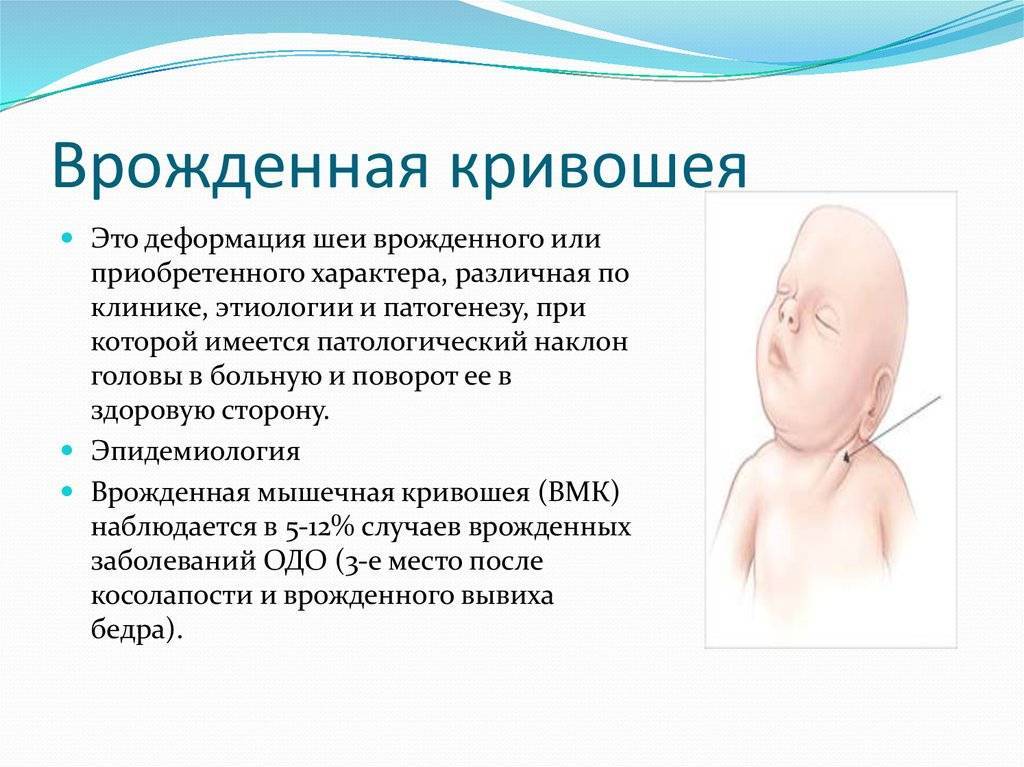
 As a result, the body is strongly curved.
As a result, the body is strongly curved.